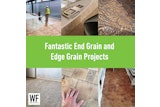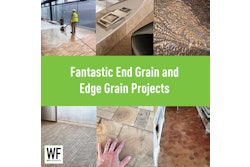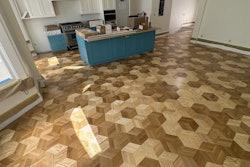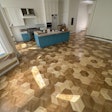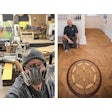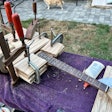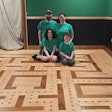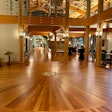
Demand for white oak, and specifically quartersawn lumber, has drastically increased in recent years. We all know that white oak plank has been on trend for flooring for years, but the bourbon and wine industries are creating intense demand for white oak logs recently. So many little niche distilleries and wineries have popped up, and they need one specific species: Quercus alba, or white oak. Barrel stave companies need the white oak for its tannins, which affect the taste and color of the bourbon and wine, and they need quartersawn cuts for stability. And unfortunately, those barrel stave companies have much deeper pockets than the mills producing wood flooring.
The pressure on white oak is now so great that there’s even been legislation introduced in Congress addressing what is predicted to be a shortage of white oak in the next 10–15 years. The bill intends to correct the course of current trends to ensure there is a sustainable supply of white oak in the United States in the future (see the sidebar “The White Oak Initiative” on page 39).
While we don’t have a shortage of white oak at this point, everyone in the wood flooring industry is feeling the effects of increased demand, and of course that means higher prices. We recently bid $1.35/board foot on 17,000 board feet of standing timber, which is close to $23,000. They weren’t even special logs; they had an average diameter of 16 inches, which is on the border of being able to be quartersawn. A barrel company bid $42,000 for the same timber—that’s what we’re dealing with every day. What that translates to is that a red oak rift and quartered plank can easily cost $5 less per square foot than the same flooring in white oak. For character livesawn oak, the price difference is probably 30 percent between the two species; for rift and quartersawn in select grade, red oak is probably about half the cost of white oak right now.
 At the Buffalo AKG Art Museum, installing rift-and-quartered clear Northern red oak plank saved the museum $8/square foot for 30,000 square feet over using white oak plank while still providing a clean aesthetic. (Photo provided by Allegheny Mountain Hardwood Flooring, courtesy of Installers Warehouse)
At the Buffalo AKG Art Museum, installing rift-and-quartered clear Northern red oak plank saved the museum $8/square foot for 30,000 square feet over using white oak plank while still providing a clean aesthetic. (Photo provided by Allegheny Mountain Hardwood Flooring, courtesy of Installers Warehouse)
The red oak stigma
Today’s preference for white oak over red oak is a massive change from historical preferences. For decades, practically every new house had red oak strip flooring, and that preference lasted until relatively recently. The WFB State of the Industry survey shows that in 2022, distributors said 35% of their species sold was white oak, compared with 27% red oak. Ten years before, in 2012, the numbers were 24% white oak versus 37% red oak. And 20 years earlier, in 2002, distributors said their red oak sales were more than double white oak: 21% white oak versus 43% red oak.
Whether the change can be attributed in part to the preference for plank flooring or simply a change in taste away from the red/pink tones, one thing is certain: Among many of today’s consumers, red oak has a stigma. People may walk into the showroom, see a red oak floor and say, “Oh my God, I love that!” and then when they hear “red oak,” someone has planted the idea in their head that red oak is unacceptable. We’d estimate that at least 75% of the time, people have a negative connotation about red oak. Usually if they like the look of a red oak floor and they aren’t working with a designer, we can convince them it’s OK—particularly with the price difference. But if they are working with an architect or designer, they usually cave to what the architect or designer say they want—leading to even more demand for white oak.
 In the Floors by the Shore showroom, they find that seeing is believing, Adam Bissey says: “There’s such a negative connotation with pink tones that until you see the red oak in person, it’s much harder to sell customers on it. In our showroom, we have a large section of red oak livesawn flooring finished with Loba Invisible (shown above), and most people who come in looking for white oak notice it and comment on it. Seeing that sample in the showroom or seeing a large sample with the right finish convinces them that red oak is an option.”
In the Floors by the Shore showroom, they find that seeing is believing, Adam Bissey says: “There’s such a negative connotation with pink tones that until you see the red oak in person, it’s much harder to sell customers on it. In our showroom, we have a large section of red oak livesawn flooring finished with Loba Invisible (shown above), and most people who come in looking for white oak notice it and comment on it. Seeing that sample in the showroom or seeing a large sample with the right finish convinces them that red oak is an option.”
Understanding the actual differences
A lot of that attitude probably stems from a lack of education about what the different floors actually look like. To start, it’s important to understand what we are referring to by “red oak” and “white oak.” “White oak” is Quercus alba. “Red oak” is Quercus rubra, but also lumped in with what we call “red oak” is black oak and many other subspecies of red oak, which leads to an inherent variety of color.
One factor in the bias against red oak is the image people have in their heads of a red oak floor: typically a 2¼-inch strip plainsawn floor that takes them back to a look that seems dated to the ’50s, ’60s or even the ’80s. When you look at a rift and quartered red oak plank floor, though, nothing about it screams dated. Everyone, from the homeowners to the architects and designers specifying these products, need more education about what the different cuts of different species actually look like.
Where the logs come from—as in, their geographic location—also affects their appearance, even when they are the same species. Northern red oak is noticeably less pink than red oak from southern regions, and southern red oak has a much wider variation in color. And because of the cold climate, with shorter summers, lumber from up north has tighter growth rings. Most wood flooring experts can glance at a red oak floor and tell from both the color and the growth rings if it came from northern or southern red oak trees.
A key difference in the appearance between the two species, besides the obvious color differences, is what the rays look like. Red oak has considerably fewer medullary rays than white oak. Sometimes in white oak quartersawn flooring, the rays will really pop out at you. We’ve even had customers ask: Is that normal? Sometimes they have almost a tiger-stripe appearance, and customers don’t realize they don’t like that look until they see it in a larger format on some boards in an installed floor.
 This Northern red oak rift-and-quartersawn select-and-better floor has Bona’s Red Out finish on it. (Photo courtesy of Allegheny Mountain Hardwood Flooring)
This Northern red oak rift-and-quartersawn select-and-better floor has Bona’s Red Out finish on it. (Photo courtesy of Allegheny Mountain Hardwood Flooring)
The effect of finishes
Because of the relentless demand for white oak, finish companies have begun creating products specifically to cancel out the pink tones of red oak and make it appear more like white oak, and the good news is that they work!
Another thing to be aware of is that different brands and types of finishes, even if they are intended to be clear or to have white tones, can either highlight or minimize the pink tones of red oak. Be sure to experiment with different products to see which give the intended color.
When a floor is going to be stained with any color in the brown or red tones, using red oak is the obvious choice. Red oak can help the color have a richer, deeper tone. Of course, the popularity of the gray colors—a trend that seems to be fading or gone entirely in some regions—led to many contractors using white oak.
 On the left is 4-inch rift and quartersawn select-and-better white oak finished with ProCoat’s Unocoat hardwax in Natural. On the right is 4-inch rift and quartersawn select-and-better red oak finished with ProCoat Invisicoat. Comparing these two images, you can see how prominent the medullary rays are in the white oak, and how much red oak tends to emphasize the riftsawn appearance. (Photos courtesy of Allegheny Mountain Hardwood Flooring)
On the left is 4-inch rift and quartersawn select-and-better white oak finished with ProCoat’s Unocoat hardwax in Natural. On the right is 4-inch rift and quartersawn select-and-better red oak finished with ProCoat Invisicoat. Comparing these two images, you can see how prominent the medullary rays are in the white oak, and how much red oak tends to emphasize the riftsawn appearance. (Photos courtesy of Allegheny Mountain Hardwood Flooring)
Availability now and in the future
There are many more red oak trees growing in the forest than white oak trees, and now, with the additional pressure on white oak demand from other industries, lead times on white oak plank are getting longer and the products are getting more expensive. The cycle of growing and cutting an oak tree is 60 to 100 years—once a generation—so there’s no quick way to create more balance in supply. The two things we can do right now are to do a better job educating consumers and the design community about how red oak can also meet their aesthetic needs, and to support the work of the White Oak Initiative to ensure a healthy supply of white oak in the future.










